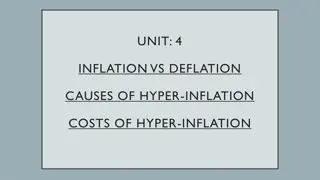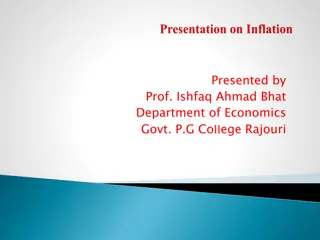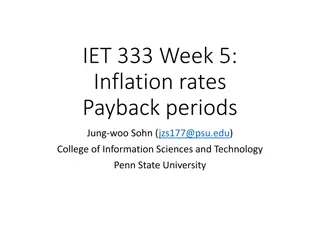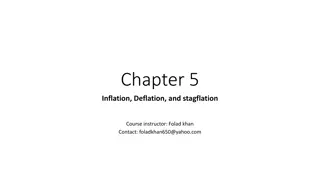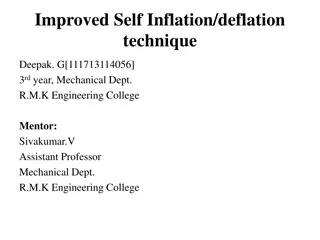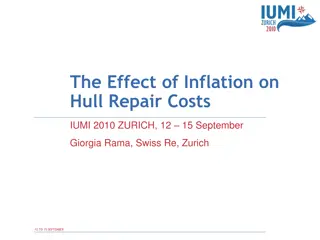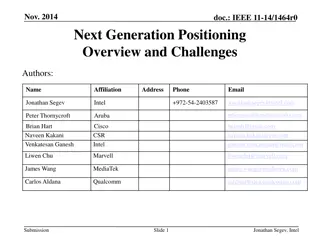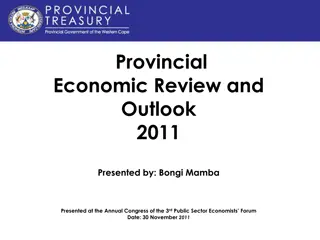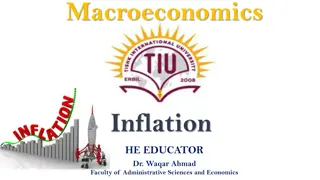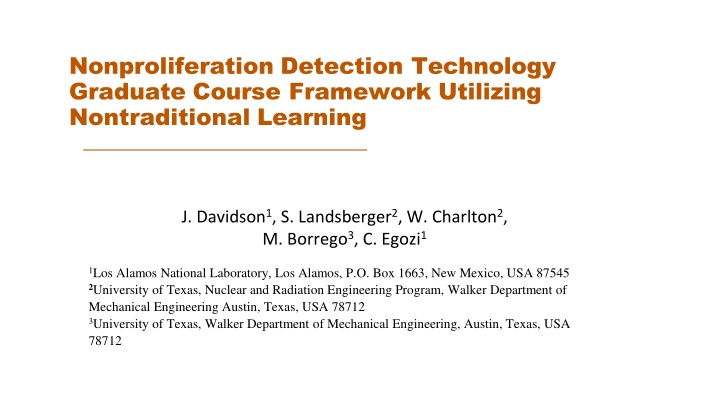
2024 Investment Outlook - Growth, Inflation, and Portfolio Positioning
This investment outlook report for 2024 covers key areas such as growth trends, inflation expectations, interest rates, company earnings, China's economic outlook, green thematic investments, and central macro themes and risk scenarios. It provides insights into global economic factors impacting investment decisions, including bear and bull cases, the implications of central bank policies, and portfolio positioning considerations. The report emphasizes that past performance does not guarantee future returns and highlights potential risks and opportunities in the market.
Uploaded on | 0 Views
Download Presentation

Please find below an Image/Link to download the presentation.
The content on the website is provided AS IS for your information and personal use only. It may not be sold, licensed, or shared on other websites without obtaining consent from the author. If you encounter any issues during the download, it is possible that the publisher has removed the file from their server.
You are allowed to download the files provided on this website for personal or commercial use, subject to the condition that they are used lawfully. All files are the property of their respective owners.
The content on the website is provided AS IS for your information and personal use only. It may not be sold, licensed, or shared on other websites without obtaining consent from the author.
E N D
Presentation Transcript
Nonproliferation Detection Technology Graduate Course Framework Utilizing Nontraditional Learning J. Davidson1, S. Landsberger2, W. Charlton2, M. Borrego3, C. Egozi1 1Los Alamos National Laboratory, Los Alamos, P.O. Box 1663, New Mexico, USA 87545 2University of Texas, Nuclear and Radiation Engineering Program, Walker Department of Mechanical Engineering Austin, Texas, USA 78712 3University of Texas, Walker Department of Mechanical Engineering, Austin, Texas, USA 78712
Overview Introduction Nuclear nonproliferation NTL Framework NTL Class Categories Student Perception (Survey Results) Conclusions
Introduction The intention of this work is to: 1. Approach a technical course in a novel/non-traditional way and 2. Create a graduate level course framework on Nonproliferation Detection Technology (NDT) 3. Study student perception and experience with non-traditional learning
Why Non-traditional Learning? Nuclear security is a multi-disciplinary field Combination between science, technology, policy, behavior sciences, military strategy, and tactics These educational disciplines are taught differently More closely represents the workplace
Why Nuclear Nonproliferation Detection Technology? Growing importance of nuclear nonproliferation Need experts who understand related technology and policy implications Unique focus Many courses on nuclear nonproliferation, but few focused on technical aspects of detection with military and political considerations Non-traditional learning is well suited, given professional structures (think tanks, political appointments, national labs, etc.) throughout nonproliferation New graduate level course on nuclear nonproliferation technology at UT Austin would fill gap in existing courses and provide students with unique perspective to aid in employment opportunities
NUCLEAR NONPROLIFERATION NTL FRAMEWORK
Understanding by Design (UbD) A 3-step approach to student centered learning that promotes a backwards design Identify learning goals and objectives Remembering Understanding Define List Identify Arrange Applying Solve Calculate Determine Implement Analyzing Solve Derive Explain Predict Evaluating Choose Prioritize Rate Critique Creating Design Develop Plan Formulate Explain Paraphrase Interpret Classify Identify assessment methods Planning instructional activities and experiences that support the achievement of learning goals
Student Feedback Loops Provides an insight mechanism, fosters continuous improvement, and enhances overall student engagement Various methods Minute papers Online surveys Suggestion box
Student Resistance Multi-faceted problem Perceived time commitments Difficulty with change Aversion to peer-to-peer interactions
Examples of NTL Class Categories 1. Pre-recorded lecture 1. Professor pre-records PowerPoint presentation (~30 mins) as homework portion 2. Class time used for problem sets and discussions on topic material 2. Just-in-time learning, decision making, and debate 1. Students given reading topics in advance of simulated activity 2. War-game scenario (e.g. simulated Russia/Ukraine conflict) 3. Mock debate (e.g. Nuclear Weapons Council type discussion/decision) 1. Potential assignment to create presentation on technology or write white paper and persuade the Council to select yours 1. Discussions on scholarly work 1. Students read article and related works outside class, lecturer discusses and moderates article discussion during class NTLclasses are flexible and can be tailored to the topic and instructor
Pre-Recorded Lectures Completed Presentations Nuclear Policy Manhattan Project to Cold War Modern Nuclear Policy National Laboratories and Nonproliferation Satellite Imaging & Nonproliferation Drones & Nonproliferation Radiation Portal Monitors Plastic Scintillators 267 slides Deemphasized and reduced the quantity of PowerPoint presentations after proposal feedback
Just-in-Time Completed Lectures Simulation of an attack on a nuclear research reactor Simulated conflict between Russia and Ukraine 63 pages Each just-in-time lecture provides the resources needed to cultivate an exercise to foster collaboration, critical thinking, and decision-making skills in a simulated scenario
Simulated Conflict Between Russia and Ukraine 1. Objective: simulate global scenario 1. Starts in 11/2021 when tensions began 2. Students represent different countries/organizations and work within groups/collaborate with others to prevent escalation of conflict and potential nuclear weapon use 3. Provides immersive and educational experience focused on nuclear nonproliferation by incorporating real- world geopolitical dynamics, diplomatic challenges, and technology aspect Aseries of events + supplemental materials
JiT Scenarios Each phase contains Evolving information and complexities In class assignments or questions Suggestions for instructor
Discussions on Scholarly Work Students complete assigned reading outside of lecture time Book section, news article, publication, etc. During class, the lecturer discusses and helps moderate a discussion regarding the assigned reading A potential assignment could be to write a position paper on the article Class time could be utilized to debate a particular stance
Case Study Review the details of the incident Why do you think the RPM alarm did not trigger? How could this be corrected? https://www.scientificamerican.com/article/detecting-nuclear-smuggling/
Student Perception NTL Pilot Overview 3 classes, one of each NTL category Integrated into ME 397 Nuclear Security Systems Design, taught by Dr. Charlton in fall 2023 End of course 20 question voluntary survey IRB exemption
Question 1 Diverse perspectives/experiences Positive engagement emphasizing interactive , discussion , debate , rebuttal , and fun Disengagement or distraction with responses such as chaos and distraction Workload perceptions homework , reading , self- teaching , self-study , and preparation Flexibility freeform 1. List three words that come to mind when you hear flipped classrooms Survey No. Word1 Word2 Word3 Self- teaching 1 Reading Homework 2 Self-Study Socratic Debate 3 Preparation Discussion Rebuttal 4 Interactive Freeform Fun 5 Buzzword Student Teacher 6 Discussion Chaos Distraction
Questions 2-16 Overview 2 3 4 5 6 7 8 9 10 11 12 13 14 15 16 Standardized testing and rote memorization Addresspreferredindividual learning approachesor styles Adaptabilityto different learning paces andabilities Studentengagement in learning Student motivationto learn Effectivenessof knowledgeretention Effectivenessof andapplication Opportunitiesfor creativity and critical thinking Promotingcritical thinking Promoting problem-solving skills Encouraging self-directed learning Real worldapplicationof knowledgeandskills Preparationfor future career prospects Takingownershipof [one s/your]own education Yourpreferred learning environment ResponseColorLegend Traditional Classrooms (T) FlippedClassrooms (F) Nopreference
Questions 2-16 Traditional classrooms (T) 42% Flipped classrooms (F) 39% No preference (N) 19% Unexpected number of no preference responses Survey Question No. 2 3 4 5 6 7 8 9 10 11 12 13 14 15 16 3 T F 6 T F 1 T T T F 2 T T T F 4 T T F N F 5 T T F F F F F F F T N N T T T T T F N F F F F F F F N F N F T F N F T T F N N T T F F N T F N T T N T F N T T N T F F F N N T F F T T T T T N T T
Removing No Preference Questions 2-16 Further analysis, removing no preference responses Percentage of Total Responses Survey No. T F Flipped Traditional 3 6 1 2 4 5 2 3 7 9 3 13 8 5 4 4 1 87% 73% 42% 31% 57% 9% 13% 27% 58% 69% 43% 91% 10 Percentage of FlippedResponses4
Traditional Learning Preferred for Testing and memorization (Question 2, 7) Addressing preferred individual learning styles (Question 3) Self-directed learning (Question 12) Real world applications (Question 13) Preparation for future career prospects (Question 14) Overall teaching style (Question 16)
Equal Responses for Learning environments best suited for students motivation to learn (Question 6) Effectiveness of application (Question 8) Promoting problem-solving skills (Question 11)
Flipped Classrooms Preferred for Adaptability to different learning paces & abilities (Question 4) Student engagement in learning (Question 5) Opportunities for creativity and creative thinking (Question 9) Promoting critical thinking (Question 10) Taking ownership of one s own education (Question 15)
Conclusions Innovative pedagogical practices Specifically to the technical field Preparing students for the complexities of nuclear security challenges NTL Nuclear Nonproliferation Course Framework 7 Pre-recorded lectures, 2 JiT learning scenarios Course structure, guidelines, and resources Student Perception survey and results Small sample size, less than half the class 6 out of 13 students Survey did not capture in person vs virtual status We acknowledge the support of Los Alamos National Laboratory LA-UR-24-23448

